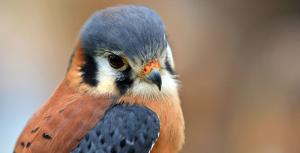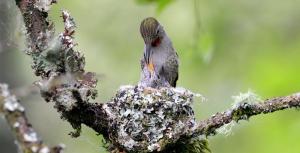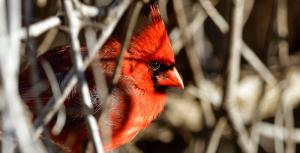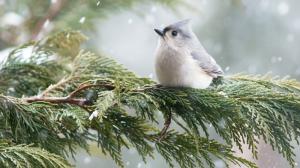Compiled by Nancy Brannon
The National Audubon Society’s Christmas Bird Count (CBC) happens every year between December 14 and January 5, and 2020 marked the 121st annual CBC. The Christmas Bird Count is a long-standing program of the National Audubon Society, with over 100 years of community science involvement. It is an early-winter bird census, where thousands of volunteers across the U.S., Canada, and many countries in the Western Hemisphere go out over a 24-hour period on one calendar day to count birds.
There is a specific methodology to the CBC. Each count takes place in an established 15-mile wide diameter circle, and is organized by a count compiler. Count volunteers follow specified routes through a designated 15-mile (24-km) diameter circle, counting every bird they see or hear all day. It’s not just a species tally—all birds are counted all day, giving an indication of the total number of birds in the circle that day.
All participants must make arrangements in advance to participate with the circle compiler within an established circle, but anyone can participate. If you are a beginning birder, you will be able to join a group that includes at least one experienced birdwatcher.
You may think songbirds are plentiful, but people are actually seeing far fewer of them than just 50 years ago. A study published in October 2019 in the journal Science estimates that North America is home to nearly three billion fewer birds today compared to 1970—that’s more than 1 in 4 birds that have disappeared from the landscape in a mere half a century. “This was an astounding result, even to us!” said lead author and Cornell Lab of Ornithology conservation scientist Ken Rosenberg.
This is sad verification of my own anecdotal bird observations on our farm. When we first moved to the farm some 35 years ago, there were plenty of Meadowlarks; now there are none. The Red-winged blackbird used to be the first bird I saw at our front pond, announcing the coming of spring. Now I see none on the farm, but do see some in the wetlands north of the Loosahatchie River and I have seen several around the pond next to our office in Arlington, Tenn.
This study, “Decline of the North American avifauna,” marks the first time experts have tried to estimate sheer numbers of avian losses in the Western Hemisphere. Typically, conservation studies focus on a specific species, habitat, region, or type of threat. By taking a higher-level view, the study highlights that many birds we still consider common, ranging from Baltimore Orioles to Dark-eyed Juncos to Barn Swallows, are actually posting heavy population losses over time.
The research team—which included collaborators at the American Bird Conservancy, Smithsonian Conservation Biology Institute, U.S. Geological Survey, the Canadian Wildlife Service, and other institutions—analyzed the breeding population of 529 species by pooling data from the North American Breeding Bird Survey, Audubon’s Christmas Bird Count, U.S. Fish and Wildlife Service waterfowl surveys, and 10 other datasets. They also analyzed more recent data collected by weather radar technology that can track large groups of birds as they migrate to estimate their numbers.
The overall picture is clear, especially because the radar and survey data tell the same story of losses, says Nicole Michel, senior quantitative ecologist at the National Audubon Society. “Unfortunately for the birds, I think we can be very confident in these results.”
Scott Loss, an Oklahoma State University ecologist not directly involved in the study, agreed: “We know birds are in decline, but this is a really sobering picture of that decline.”
There isn’t one single factor that can account for these pervasive losses, says Rosenberg. Habitat loss is likely an important driver in some biomes, but can’t explain the widespread declines on its own, says Arvind Panjabi, avian conservation scientist at Bird Conservancy of the Rockies and a study co-author. Multiple, complex environmental factors including pesticide use, insect declines, and climate change, as well as direct threats like outdoor cats and glass skyscrapers, are also hitting birds from a range of angles. For migratory species, long journeys and changes to winter habitats could pose additional challenges. The study itself doesn’t look at causes, but the results point to how human influence over the last 50 years has chipped away at bird populations, says Michel.
The study serves, in many ways, as a wake-up call. By making the dramatic losses concrete, Rosenberg hopes people will be jolted into action. Cornell and its partners (which include the National Audubon Society) have launched the website 3BillionBirds.org to share the findings and promote bird-saving solutions.
Read more about this study at: https://www.audubon.org/news/north-america-has-lost-more-1-4-birds-last-50-years-new-study-says
Read more about the Audubon Christmas Bird Count here: https://www.audubon.org/conservation/join-christmas-bird-count
Source:
Rosenberg, Kenneth V. et al. 2019. “Decline of the North American avifauna.” Science. October.
The National Audubon Society’s Christmas Bird Count (CBC) happens every year between December 14 and January 5, and 2020 marked the 121st annual CBC. The Christmas Bird Count is a long-standing program of the National Audubon Society, with over 100 years of community science involvement. It is an early-winter bird census, where thousands of volunteers across the U.S., Canada, and many countries in the Western Hemisphere go out over a 24-hour period on one calendar day to count birds.
There is a specific methodology to the CBC. Each count takes place in an established 15-mile wide diameter circle, and is organized by a count compiler. Count volunteers follow specified routes through a designated 15-mile (24-km) diameter circle, counting every bird they see or hear all day. It’s not just a species tally—all birds are counted all day, giving an indication of the total number of birds in the circle that day.
All participants must make arrangements in advance to participate with the circle compiler within an established circle, but anyone can participate. If you are a beginning birder, you will be able to join a group that includes at least one experienced birdwatcher.
You may think songbirds are plentiful, but people are actually seeing far fewer of them than just 50 years ago. A study published in October 2019 in the journal Science estimates that North America is home to nearly three billion fewer birds today compared to 1970—that’s more than 1 in 4 birds that have disappeared from the landscape in a mere half a century. “This was an astounding result, even to us!” said lead author and Cornell Lab of Ornithology conservation scientist Ken Rosenberg.
This is sad verification of my own anecdotal bird observations on our farm. When we first moved to the farm some 35 years ago, there were plenty of Meadowlarks; now there are none. The Red-winged blackbird used to be the first bird I saw at our front pond, announcing the coming of spring. Now I see none on the farm, but do see some in the wetlands north of the Loosahatchie River and I have seen several around the pond next to our office in Arlington, Tenn.
This study, “Decline of the North American avifauna,” marks the first time experts have tried to estimate sheer numbers of avian losses in the Western Hemisphere. Typically, conservation studies focus on a specific species, habitat, region, or type of threat. By taking a higher-level view, the study highlights that many birds we still consider common, ranging from Baltimore Orioles to Dark-eyed Juncos to Barn Swallows, are actually posting heavy population losses over time.
The research team—which included collaborators at the American Bird Conservancy, Smithsonian Conservation Biology Institute, U.S. Geological Survey, the Canadian Wildlife Service, and other institutions—analyzed the breeding population of 529 species by pooling data from the North American Breeding Bird Survey, Audubon’s Christmas Bird Count, U.S. Fish and Wildlife Service waterfowl surveys, and 10 other datasets. They also analyzed more recent data collected by weather radar technology that can track large groups of birds as they migrate to estimate their numbers.
The overall picture is clear, especially because the radar and survey data tell the same story of losses, says Nicole Michel, senior quantitative ecologist at the National Audubon Society. “Unfortunately for the birds, I think we can be very confident in these results.”
Scott Loss, an Oklahoma State University ecologist not directly involved in the study, agreed: “We know birds are in decline, but this is a really sobering picture of that decline.”
There isn’t one single factor that can account for these pervasive losses, says Rosenberg. Habitat loss is likely an important driver in some biomes, but can’t explain the widespread declines on its own, says Arvind Panjabi, avian conservation scientist at Bird Conservancy of the Rockies and a study co-author. Multiple, complex environmental factors including pesticide use, insect declines, and climate change, as well as direct threats like outdoor cats and glass skyscrapers, are also hitting birds from a range of angles. For migratory species, long journeys and changes to winter habitats could pose additional challenges. The study itself doesn’t look at causes, but the results point to how human influence over the last 50 years has chipped away at bird populations, says Michel.
The study serves, in many ways, as a wake-up call. By making the dramatic losses concrete, Rosenberg hopes people will be jolted into action. Cornell and its partners (which include the National Audubon Society) have launched the website 3BillionBirds.org to share the findings and promote bird-saving solutions.
Read more about this study at: https://www.audubon.org/news/north-america-has-lost-more-1-4-birds-last-50-years-new-study-says
Read more about the Audubon Christmas Bird Count here: https://www.audubon.org/conservation/join-christmas-bird-count
Source:
Rosenberg, Kenneth V. et al. 2019. “Decline of the North American avifauna.” Science. October.










